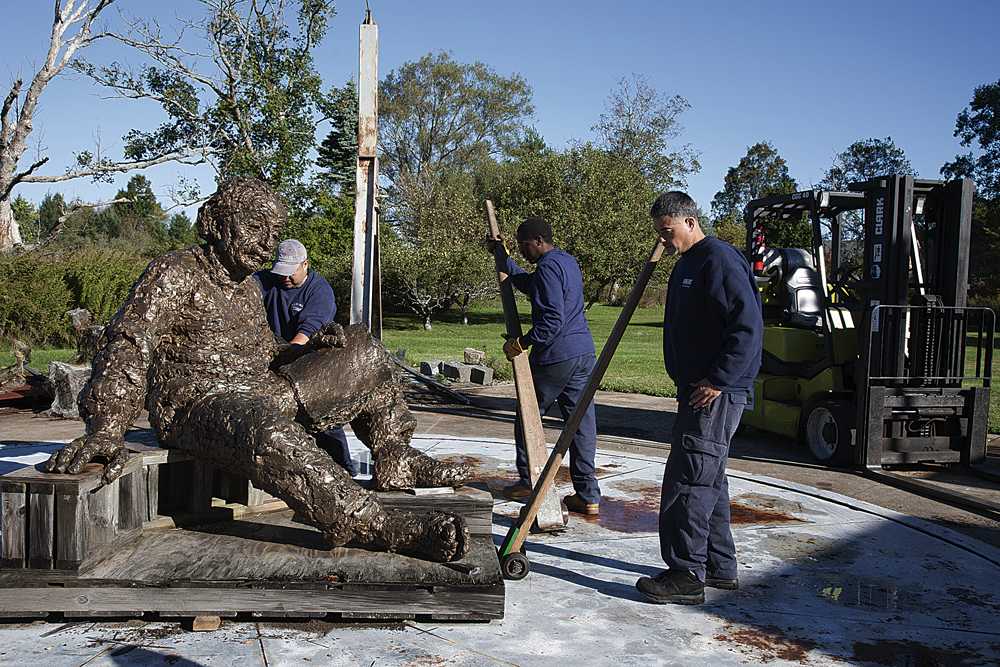Orient’s sculpture of Albert Einstein finds a new home at Georgia Tech

Three large moving trucks and a crane pulled up to the secluded driveway of the late Bob Berks’ Orient studio last month.
No one was moving away from the five-home street, however — no sentient being, anyway.
Instead, it was Albert Einstein — rather, a 12-foot bronze sculpture of his likeness — that was being transported from his longtime home on the North Fork to Atlanta.
“[We’ve been] waiting for the proper place for what Bob envisioned,” Mr. Berks’ wife, Dorothy “Tod” Berks, said. “That turned out to be Georgia Tech.”
Mr. Berks, who died in May 2011 at age 89, was a sculptor, designer and industrial planner who created hundreds of sculptures and monuments during his lifetime. Some of his most famous pieces are busts of Abraham Lincoln and John F. Kennedy, the latter of which is located at the Kennedy Center in Washington, D.C.
Her husband’s goal, Ms. Berks explained, was to pass down portraitures of famous people throughout generations, sharing their lessons.
Sending the Einstein sculpture to a school rather than a museum appealed to Ms. Berks, who said she likes the idea that academics will view her husband’s work on a daily basis.
“Georgia Tech is on an interesting direction of expanding the view of science in the world and they’re including art in all forms — dance, sculpture, painting, music — to the campus and to the student body and it’s taking off really well,” Ms. Berks said. “This is the sort of thing that Bob would have liked.”
The sculpture spent most of its life at the Berks’ Orient home. It was originally designed for the American Museum of Natural History’s Einstein exhibit, where it spent a year traveling. Since then, it’s remained in Orient, where it was visited each year by sixth-graders from Oysterponds Elementary School.
Each spring before their class trip to Washington D.C., Ms. Berks said, the students took a tour of the studio. They would then pose for a group photo with the statue.
“This, to me, was a very sentimental thing,” she said.
Created in 2004, the piece is the third and final Einstein sculpture Mr. Berks made. His first sculpture, which stands 22 feet tall, was dedicated to the National Academy of Sciences in Washington, D.C., in 1979 as part of a centennial celebration of Mr. Einstein’s life.
Around 1999, Mr. Berks was commissioned to replicate the sculpture on a smaller scale of 12 feet tall to be sent to the Israel Academy of Sciences and Humanities in Jerusalem.
All three sculptures were based on a two-day meeting Mr. Berks had with Mr. Einstein in 1953 and designed to capture the way he looked at the time. The sculptures are similar and each sit on a granite circle containing a map of the universe — a metaphor for Mr. Einstein having the world at his feet. The stones also feature constellations for specific dates.
For instance, the statue recently transferred to Georgia Tech contains a map of the constellations above Atlanta on Dec. 10, 1948 — the day the Universal Declaration of Human Rights was adopted.
Created after World War II, the United Nations declaration outlines the basic way all people deserve to be treated.
While Georgia Tech is a “perfect home” for Einstein, those who frequented the statue in Orient say it will be missed.
Sarah Prescott, a former William Steeple Davis Artist-in-Residence who works at the studio with Ms. Berks, is among them.
“I’ll miss him because I sat with him a lot with my little lawn chair and I would eat my lunch and tell Einstein my problems,” Ms. Prescott said. “It’s silly, but I really am thrilled. It’s a great home and a great fit.”
Photo Caption: Movers prepare to transport Bob Berks’ 12-foot bronze Einstein sculpture from Orient to Atlanta last month. (Credit: Sarah Prescott, courtesy)








